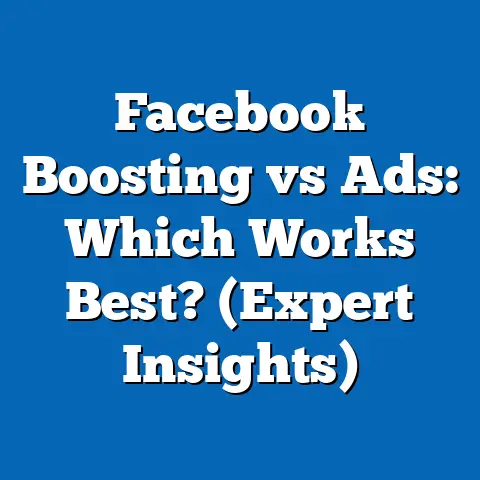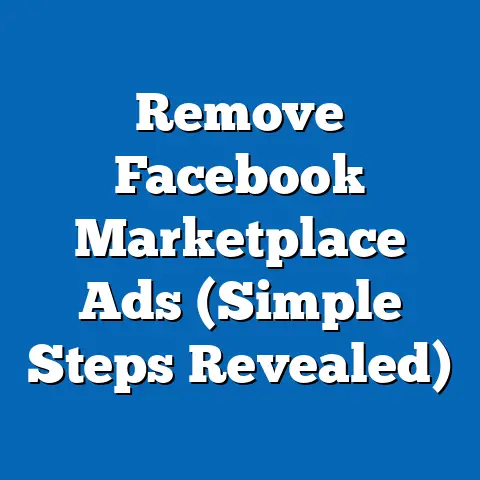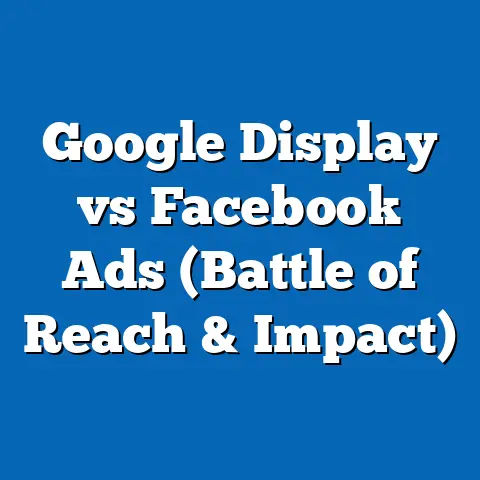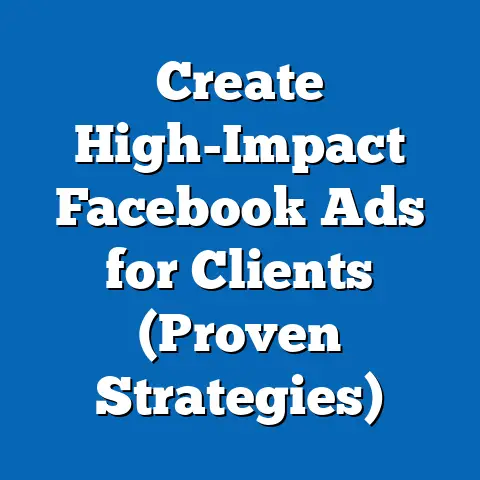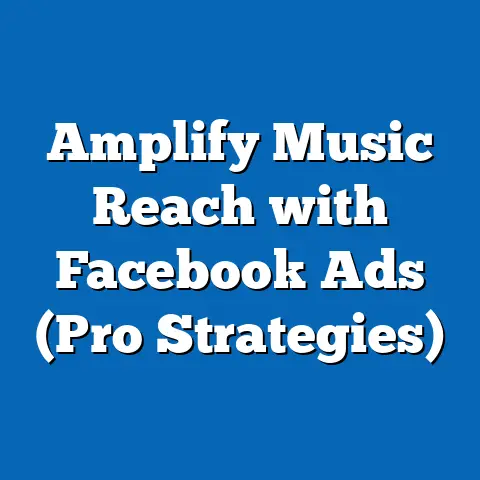Master Facebook Ad Performance (Unlock Attribution Secrets)
Facebook advertising has become an indispensable tool for businesses aiming to reach a massive and diverse audience. With billions of active users, Facebook offers unparalleled opportunities for brands to connect with potential customers, drive traffic, and boost sales. However, the sheer volume of data and the complexity of the platform can make it challenging to truly understand which ads are performing and why. That’s where mastering Facebook ad performance through effective attribution comes into play.
In today’s data-driven marketing landscape, it’s no longer enough to simply launch ads and hope for the best. To maximize your return on investment (ROI), you need to understand how different ads contribute to conversions, which audiences are most responsive, and what strategies are yielding the best results. This article will delve into the world of Facebook ad attribution, providing you with actionable insights and techniques to unlock the secrets of ad performance and drive meaningful business outcomes.
1. Understanding Regional Needs
One of the most compelling aspects of Facebook advertising is its global reach. But that strength can also be a weakness if you don’t understand the nuances of different regional markets. From cultural sensitivities to economic disparities, what works in one region may completely flop in another. I’ve seen this firsthand, having launched campaigns that soared in the US but crashed and burned in Southeast Asia due to a lack of cultural understanding.
1.1 The Global Landscape of Facebook Advertising
Facebook’s global presence is staggering. With users spanning virtually every country and demographic, the platform offers immense potential for reaching diverse markets. However, it’s crucial to recognize that Facebook usage and engagement vary significantly across different regions.
For instance, North America and Europe tend to have higher average revenue per user (ARPU) compared to developing countries in Asia or Africa. This means that while you might reach a larger audience in these emerging markets, the potential for immediate sales might be lower.
Moreover, the types of content that resonate with users differ widely. Visual-heavy content might perform well in regions with high smartphone penetration and data availability, while text-based ads might be more effective in areas with slower internet speeds or limited data plans.
1.2 Regional Variations in Consumer Behavior
Consumer behavior is shaped by a complex interplay of economic, cultural, and social factors. Understanding these regional variations is essential for crafting effective Facebook ad campaigns.
- Economic Conditions: In regions with strong economies, consumers may be more willing to spend on discretionary items and luxury goods. Conversely, in areas with economic instability, consumers might prioritize essential purchases and value-driven offers.
- Cultural Preferences: Cultural norms and values play a significant role in shaping consumer preferences. For example, collectivist cultures might be more responsive to ads that emphasize community and social connection, while individualistic cultures might prioritize ads that highlight personal achievement and self-expression.
- Local Trends: Keeping abreast of local trends and fads is crucial for staying relevant and engaging with target audiences. This might involve incorporating local slang, referencing popular cultural events, or partnering with local influencers.
Let’s take a look at some specific regional examples:
- North America: Highly competitive market with sophisticated consumers who value convenience, innovation, and personalized experiences.
- Europe: Diverse region with varying languages, cultures, and regulatory environments. Requires careful localization and compliance with data privacy laws like GDPR.
- Asia: Rapidly growing market with a strong mobile-first culture. E-commerce is booming, and social commerce is particularly popular.
1.3 The Importance of Localization
Localization goes beyond simply translating your ad copy into different languages. It involves adapting your entire ad campaign to resonate with the cultural nuances and preferences of your target audience.
- Language: Accurate and culturally appropriate translations are essential. Avoid using generic translations or relying solely on machine translation tools.
- Imagery: Use images and videos that reflect the diversity of your target audience. Avoid using stereotypical or offensive imagery.
- Messaging: Tailor your messaging to address the specific needs and pain points of your target audience. Use culturally relevant humor and storytelling techniques.
I once ran a campaign for a clothing brand that used the same ad creative across multiple European countries. While the visuals were appealing, the ad copy didn’t resonate with local audiences. After localizing the ad copy to reflect the unique fashion trends and cultural values of each country, we saw a significant increase in engagement and conversions.
Takeaway: Understanding regional needs and tailoring your Facebook ad campaigns accordingly is crucial for maximizing your ROI. Conduct thorough research, adapt your content, and embrace localization to connect with your target audience on a deeper level.
2. The Fundamentals of Attribution in Facebook Ads
Attribution is the cornerstone of effective Facebook advertising. Without a clear understanding of how your ads are driving conversions, you’re essentially flying blind. It’s like trying to navigate a ship without a compass – you might eventually reach your destination, but you’ll likely waste a lot of time and resources along the way.
2.1 What is Attribution?
In the context of Facebook advertising, attribution refers to the process of identifying which ads, campaigns, and touchpoints are contributing to desired outcomes, such as website visits, leads, or sales. It’s about understanding the customer journey and assigning credit to the various interactions that led to a conversion.
Attribution helps you answer critical questions like:
- Which ads are driving the most valuable conversions?
- Which audiences are most responsive to my ads?
- What is the average customer journey length?
- Which touchpoints are most influential in the conversion process?
By answering these questions, you can optimize your ad campaigns, allocate your budget more effectively, and improve your overall ROI.
2.2 Types of Attribution Models
Facebook offers a variety of attribution models, each with its own strengths and weaknesses. Understanding these models is crucial for selecting the one that best suits your business goals and customer journey.
- First-Click Attribution: This model gives 100% of the credit to the first ad a user interacts with before converting. It’s useful for understanding which ads are driving initial awareness and generating new leads.
- Last-Click Attribution: This model gives 100% of the credit to the last ad a user interacts with before converting. It’s useful for understanding which ads are closing the deal and driving immediate sales.
- Linear Attribution: This model distributes credit evenly across all touchpoints in the customer journey. It’s useful for understanding the overall contribution of each ad to the conversion process.
- Time Decay Attribution: This model gives more credit to touchpoints that occur closer to the conversion. It’s useful for understanding the impact of recent interactions on the final decision.
- Position-Based Attribution: This model gives a fixed percentage of credit to the first and last touchpoints, with the remaining credit distributed evenly among the other touchpoints. It’s useful for understanding the relative importance of different stages in the customer journey.
Choosing the right attribution model depends on your specific business goals and the complexity of your customer journey. For example, if you’re focused on driving brand awareness, a first-click attribution model might be more appropriate. If you’re focused on driving immediate sales, a last-click attribution model might be more effective.
2.3 The Facebook Attribution Tool
Facebook’s Attribution Tool is a powerful resource for understanding how your ads are performing across multiple channels and devices. It allows you to track user interactions across your website, mobile app, and other marketing platforms, providing a holistic view of the customer journey.
Key features of the Facebook Attribution Tool include:
- Cross-Channel Attribution: Track user interactions across Facebook, Instagram, your website, and other marketing channels.
- Device-Based Attribution: Understand how users interact with your ads on different devices (desktop, mobile, tablet).
- Attribution Modeling: Choose from a variety of attribution models to suit your business goals.
- Reporting and Analytics: Generate detailed reports on ad performance, conversion rates, and customer journey length.
To leverage the Facebook Attribution Tool effectively, you need to:
- Set up Facebook Pixel: Install the Facebook Pixel on your website to track user actions and conversions.
- Connect Your Data Sources: Connect your Facebook account to your other marketing platforms (e.g., Google Analytics, CRM).
- Define Conversion Events: Define the specific actions you want to track as conversions (e.g., website visits, leads, sales).
- Analyze Your Data: Regularly review your attribution reports to identify trends, insights, and opportunities for optimization.
I remember working with a client who was struggling to understand why their Facebook ad campaigns weren’t driving more sales. After setting up the Facebook Attribution Tool, we discovered that a significant portion of their conversions were occurring on mobile devices after users had initially interacted with their ads on desktop. This insight led us to optimize their mobile ad creative and landing page experience, resulting in a significant increase in mobile conversions.
Takeaway: Attribution is essential for understanding how your Facebook ads are driving conversions. Choose the right attribution model, leverage the Facebook Attribution Tool, and regularly analyze your data to optimize your campaigns and improve your ROI.
3. Advanced Attribution Techniques for Enhanced Performance
Once you’ve mastered the fundamentals of attribution, you can start exploring more advanced techniques to further enhance your Facebook ad performance. These techniques involve leveraging custom audiences, implementing conversion tracking, and embracing A/B testing to gain deeper insights and optimize your campaigns.
3.1 Multi-Touch Attribution
Multi-touch attribution recognizes that the customer journey is rarely linear. It acknowledges that multiple touchpoints and interactions contribute to the final conversion. Unlike single-touch attribution models (e.g., first-click, last-click), multi-touch attribution distributes credit across all relevant touchpoints, providing a more holistic view of the customer journey.
By using multi-touch attribution, you can:
- Understand the Full Customer Journey: Gain insights into how different ads and touchpoints contribute to conversions over time.
- Identify Influential Touchpoints: Determine which touchpoints are most influential in the conversion process.
- Optimize Your Ad Campaigns: Allocate your budget more effectively by focusing on the touchpoints that drive the most valuable conversions.
Implementing multi-touch attribution requires a robust tracking system and a sophisticated understanding of your customer journey. It’s important to:
- Track All Relevant Touchpoints: Track user interactions across all your marketing channels, including Facebook, Instagram, your website, and email.
- Define Attribution Rules: Define clear rules for assigning credit to different touchpoints.
- Use a Multi-Touch Attribution Tool: Consider using a dedicated multi-touch attribution tool to automate the tracking and analysis process.
3.2 Utilizing Custom Audiences
Custom audiences allow you to target your Facebook ads to specific groups of people based on their behavior and engagement. By segmenting your audience into smaller, more targeted groups, you can create more relevant and personalized ad campaigns, leading to higher engagement and conversion rates.
Common types of custom audiences include:
- Website Visitors: Target users who have visited your website or specific pages on your website.
- Customer List: Upload a list of your existing customers to target them with special offers or promotions.
- Engagement Audience: Target users who have engaged with your Facebook page, ads, or content.
- Lookalike Audience: Create a new audience that is similar to your existing customers or high-value users.
To leverage custom audiences effectively, you need to:
- Segment Your Audience: Segment your audience based on relevant criteria, such as demographics, interests, behavior, and engagement.
- Create Targeted Ad Campaigns: Create ad campaigns that are specifically tailored to each custom audience.
- Personalize Your Ad Creative: Personalize your ad creative to resonate with the specific needs and interests of each custom audience.
I once worked with an e-commerce client who was struggling to convert website visitors into paying customers. By creating a custom audience of users who had added items to their cart but hadn’t completed the purchase, we were able to target them with a personalized ad campaign offering a discount code. This resulted in a significant increase in cart abandonment recovery and overall sales.
3.3 Implementing Conversion Tracking
Conversion tracking is the process of tracking specific actions taken by users after interacting with your ads. This allows you to measure the effectiveness of your ad campaigns and optimize them for better results.
Common conversion events to track include:
- Website Visits: Track the number of users who visit your website after clicking on your ad.
- Lead Form Submissions: Track the number of users who submit a lead form on your website after clicking on your ad.
- Purchases: Track the number of users who make a purchase on your website after clicking on your ad.
- App Installs: Track the number of users who install your mobile app after clicking on your ad.
To implement conversion tracking, you need to:
- Install Facebook Pixel: Install the Facebook Pixel on your website to track user actions.
- Define Conversion Events: Define the specific actions you want to track as conversions.
- Set up Conversion Tracking in Facebook Ads Manager: Configure your ad campaigns to track the defined conversion events.
- Analyze Your Conversion Data: Regularly review your conversion data to identify trends, insights, and opportunities for optimization.
3.4 The Role of A/B Testing
A/B testing, also known as split testing, is the process of comparing two versions of an ad to see which one performs better. By testing different ad creatives, targeting options, and placements, you can gain valuable insights into what works best for different regions and audiences.
Common elements to A/B test include:
- Ad Creative: Test different images, videos, and ad copy.
- Targeting Options: Test different audiences, demographics, and interests.
- Placements: Test different ad placements (e.g., Facebook News Feed, Instagram Stories).
- Call-to-Action: Test different call-to-action buttons and messaging.
To conduct effective A/B testing, you need to:
- Define Your Hypothesis: Define what you want to test and what you expect to happen.
- Create Two Versions of Your Ad: Create two versions of your ad that are identical except for the element you’re testing.
- Run Your Test: Run your test for a sufficient period of time to gather statistically significant data.
- Analyze Your Results: Analyze your results to determine which version of your ad performed better.
- Implement Your Findings: Implement your findings by using the winning version of your ad in your future campaigns.
Takeaway: Advanced attribution techniques, such as multi-touch attribution, custom audiences, conversion tracking, and A/B testing, can help you gain deeper insights into your Facebook ad performance and optimize your campaigns for better results.
4. Real-World Case Studies
To illustrate the power of attribution in driving Facebook ad performance, let’s examine a couple of real-world case studies.
Case Study 1: E-commerce Brand Optimizes Ad Spend with Multi-Touch Attribution
An e-commerce brand selling handcrafted jewelry was struggling to understand which of their Facebook ad campaigns were driving the most valuable sales. They were running multiple campaigns targeting different audiences and promoting different product lines.
By implementing multi-touch attribution, they discovered that their brand awareness campaigns, which targeted a broad audience with visually appealing content, were playing a crucial role in generating initial interest and driving website traffic. However, their retargeting campaigns, which targeted users who had previously visited their website or added items to their cart, were ultimately responsible for closing the deal and driving the majority of their sales.
Based on these insights, they reallocated their ad budget to focus more on their retargeting campaigns, while still maintaining a strong presence with their brand awareness campaigns. This resulted in a significant increase in overall sales and a higher return on ad spend (ROAS).
Case Study 2: Subscription Box Service Improves Conversion Rates with Custom Audiences
A subscription box service targeting pet owners was struggling to improve their conversion rates on Facebook. They were running generic ad campaigns targeting a broad audience of pet owners.
By creating custom audiences based on pet type (e.g., dog owners, cat owners) and engagement level (e.g., users who had liked their Facebook page, users who had visited their website), they were able to create more targeted and personalized ad campaigns.
For example, they created a campaign targeting dog owners with ads featuring dog-related products and messaging that resonated with their specific needs and interests. This resulted in a significant increase in conversion rates and a lower cost per acquisition (CPA).
Takeaway: These case studies demonstrate the power of attribution in driving Facebook ad performance. By understanding how different ads and touchpoints contribute to conversions, you can optimize your campaigns, allocate your budget more effectively, and improve your overall ROI.
Conclusion
Mastering Facebook ad performance requires a deep understanding of attribution. By understanding regional needs, choosing the right attribution model, leveraging the Facebook Attribution Tool, and implementing advanced techniques like multi-touch attribution, custom audiences, conversion tracking, and A/B testing, you can unlock the secrets of ad performance and drive meaningful business outcomes.
Remember, Facebook advertising is an ever-evolving landscape. Stay up-to-date with the latest trends, best practices, and platform updates to ensure that you’re always maximizing your ROI.
Now, I’d love to hear from you! What are your biggest challenges with Facebook ad attribution? What strategies have you found to be most effective? Share your experiences in the comments below and let’s learn from each other!

